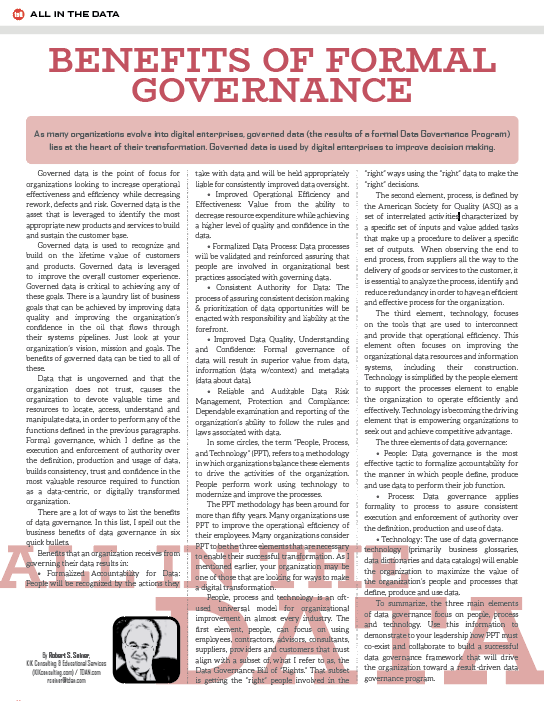The Benefits of Formal Governance
By Robert S. Seiner, KIK Consulting & Educational Services (KIKconsulting.com) / TDAN.com rseiner@tdan.com
As many organizations evolve into digital enterprises, governed data (the results of a formal Data Governance Program) lies at the heart of their transformation. Governed data is used by digital enterprises to improve decision making.
 Governed data is the point of focus for organizations looking to increase operational effectiveness and efficiency while decreasing rework, defects and risk. Governed data is the asset that is leveraged to identify the most appropriate new products and services to build and sustain the customer base.
Governed data is the point of focus for organizations looking to increase operational effectiveness and efficiency while decreasing rework, defects and risk. Governed data is the asset that is leveraged to identify the most appropriate new products and services to build and sustain the customer base.
Governed data is used to recognize and build on the lifetime value of customers and products. Governed data is leveraged to improve the overall customer experience. Governed data is critical to achieving any of these goals. There is a laundry list of business goals that can be achieved by improving data quality and improving the organization’s confidence in the oil that flows through their systems pipelines. Just look at your organization’s vision, mission and goals. The benefits of governed data can be tied to all of these.
Data that is ungoverned and that the organization does not trust, causes the organization to devote valuable time and resources to locate, access, understand and manipulate data, in order to perform any of the functions defined in the previous paragraphs. Formal governance, which I define as the execution and enforcement of authority over the definition, production and usage of data, builds consistency, trust and confidence in the most valuable resource required to function as a data-centric, or digitally transformed organization.
There are a lot of ways to list the benefits of data governance. In this list, I spell out the business benefits of data governance in six quick bullets.
Benefits that an organization receives from governing their data results in:
• Formalized Accountability for Data: People will be recognized by the actions they take with data and will be held appropriately liable for consistently improved data oversight.
• Improved Operational Efficiency and Effectiveness: Value from the ability to decrease resource expenditure while achieving a higher level of quality and confidence in the data.
• Formalized Data Process: Data processes will be validated and reinforced assuring that people are involved in organizational best practices associated with governing data.
• Consistent Authority for Data: The process of assuring consistent decision making & prioritization of data opportunities will be enacted with responsibility and liability at the forefront.
• Improved Data Quality, Understanding and Confidence: Formal governance of data will result in superior value from data, information (data w/context) and metadata (data about data).
• Reliable and Auditable Data Risk Management, Protection and Compliance: Dependable examination and reporting of the organization’s ability to follow the rules and laws associated with data.
In some circles, the term “People, Process, and Technology” (PPT), refers to a methodology in which organizations balance these elements to drive the activities of the organization. People perform work using technology to modernize and improve the processes.
The PPT methodology has been around for more than fifty years. Many organizations use PPT to improve the operational efficiency of their employees. Many organizations consider PPT to be the three elements that are necessary to enable their successful transformation. As I mentioned earlier, your organization may be one of those that are looking for ways to make a digital transformation.
People, process and technology is an oft-used universal model for organizational improvement in almost every industry. The first element, people, can focus on using employees, contractors, advisors, consultants, suppliers, providers and customers that must align with a subset of, what I refer to as, the Data Governance Bill of “Rights.” That subset is getting the “right” people involved in the “right” ways using the “right” data to make the “right” decisions.
The second element, process, is defined by the American Society for Quality (ASQ) as a set of interrelated activities characterized by a specific set of inputs and value added tasks that make up a procedure to deliver a specific set of outputs. When observing the end to end process, from suppliers all the way to the delivery of goods or services to the customer, it is essential to analyze the process, identify and reduce redundancy in order to have an efficient and effective process for the organization.
The third element, technology, focuses on the tools that are used to interconnect and provide that operational efficiency. This element often focuses on improving the organizational data resources and information systems, including their construction. Technology is simplified by the people element to support the processes element to enable the organization to operate efficiently and effectively. Technology is becoming the driving element that is empowering organizations to seek out and achieve competitive advantage.
The three elements of data governance:
• People: Data governance is the most effective tactic to formalize accountability for the manner in which people define, produce and use data to perform their job function.
• Process: Data governance applies formality to process to assure consistent execution and enforcement of authority over the definition, production and use of data.
• Technology: The use of data governance technology (primarily business glossaries, data dictionaries and data catalogs) will enable the organization to maximize the value of the organization’s people and processes that define, produce and use data.
To summarize, the three main elements of data governance focus on people, process and technology. Use this information to demonstrate to your leadership how PPT must co-exist and collaborate to build a successful data governance framework that will drive the organization toward a result-driven data governance program.